NRHP Reference # 88000143 | Added to NRHP 13 October 1988 | |
 | ||
Architect Charlton,Gilbert & Demar; Et al. Architectural style Classical Revival, Italianate, Romanesque | ||
The Quincy Street Historic District is a historic district located along the 100, 200, and 300 blocks of Quincy Street, along with 416 Tezcuco Street, in Hancock, Michigan. The Hancock Town Hall and Fire Hall is located in the district. The district was listed on the National Register of Historic Places in 1988.
Contents
Description
The Quincy Street Historic District covers the central portion of Hancock's business district consisting of the first three blocks of Quincy Street, plus two adjacent properties. The district includes three governmental structures (the Hancock Town Hall and Fire Hall, post office, and a county office building) along with forty-two commercial buildings. The majority of the structures within the district were built between 1880 and 1915. The commercial buildings range from two to five stories, and are of frame, brick, or brick and stone construction. The district is notable for the widespread use of local red Jacobsville sandstone.
History and significance
In 1869, a major fire destroyed 75 percent of the buildings in Hancock, which were primarily made of wood. This made room for the construction of more substantial structures during the latter years of the 19th century.
The district contains a large number of well-preserved structures built around the turn of the century. These structures indicate the relative prosperity of Hancock at the time, when copper mining in the Keweenaw Peninsula was a strong industry. Many of the structures were designed by leading architects of the Upper Peninsula, including Charlton, Gilbert and Demar, and are significant for their scale and quality, and the reflection of the ethnic diversity of late 19th century Hancock.
Significant buildings in the district include:
